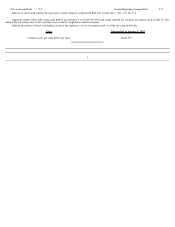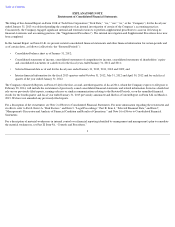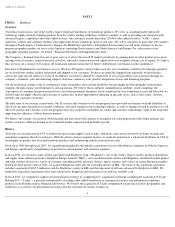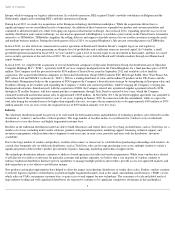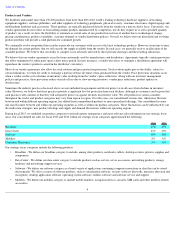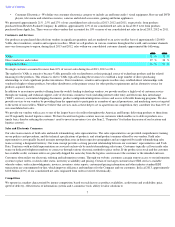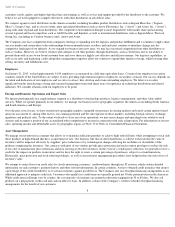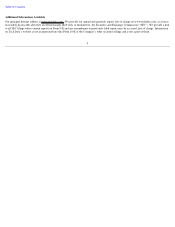Tech Data 2013 Annual Report Download - page 12
Download and view the complete annual report
Please find page 12 of the 2013 Tech Data annual report below. You can navigate through the pages in the report by either clicking on the pages listed below, or by using the keyword search tool below to find specific information within the annual report.
Table of Contents
ITEM 1A. Risk Factors.
The following are certain risk factors that could affect our business, financial position and results of operations. These risk factors should be
considered in connection with evaluating the forward-looking statements contained in this Annual Report on Form 10-
K because these factors could
cause the actual results and conditions to differ materially from those projected in the forward-looking statements. Before you buy our common
stock or other securities, you should know that making such an investment involves risks, including the risks described below. The risks that have
been highlighted below are not the only risks of our business. If any of the risks actually occur, our business, financial condition or results of
operations could be negatively affected. In that case, the trading price of our common stock or other securities could decline, and you may lose all
or part of your investment. Risk factors that could cause actual results to differ materially from our forward-looking statements are as follows:
Our ability to earn profit is more challenging when sales slow from a down economy as a result of gross profit declining faster than cost
reduction efforts taking effect.
Currently, the high levels of unemployment in many of the markets we serve, including the United States and certain countries in Europe, as well as
austerity measures that have been implemented by governments in those markets, have constrained economic growth resulting in lower demand for
the products and services we sell. When we experience a rapid decline in demand for products we experience more difficulty in achieving the gross
profit and operating profit we desire due to the lower sales and increased pricing pressure. The fragile economic environment may also result in
changes in vendor terms and conditions, such as rebates, cash discounts and cooperative marketing efforts, which may also result in downward
pressure on our gross profit. As a result, there is pressure to reduce the cost of operations in order to maximize operating profits. To the extent we
cannot reduce costs to offset such decline in operating profits, our operating margins typically deteriorate. The benefits from cost reductions may
also take longer to fully realize and may not fully mitigate the impact of the reduced demand. Should we experience a decline in operating profits,
especially in Europe, the valuations we develop for purposes of our goodwill impairment test may be adversely affected, potentially resulting in
impairment charges. Deterioration in the financial and credit markets heightens the risk of customer bankruptcies and delays in payment. Future
deterioration in the credit markets could result in reduced availability of credit insurance to cover customer accounts. This, in turn, may result in our
reducing the credit lines we provide to customers, thereby having a negative impact on our net sales.
Our competitors can take more market share by reducing prices on key vendor products that contribute the most to our profitability.
The Company operates in a highly competitive environment. The technology distribution industry is characterized by intense competition, based
primarily on product availability, credit terms and availability, price, effectiveness of information systems and e-commerce tools, speed of delivery,
ability to tailor specific solutions to customer needs, quality and depth of product lines and training, service and support. Our customers are not
required to purchase any specific volume of products from us and may move business if pricing is reduced by competitors, resulting in lower sales.
As a result, we must be extremely flexible in determining when to reduce price to maintain market share and sales volumes and when to allow our
sales volumes to fall to maintain the quality of our profitability. The Company competes with a variety of regional, national and international
wholesale distributors, some of which may have greater financial resources than the Company.
To maintain competitive internal information and telecommunication systems and to protect such systems against security breaches, data
protection breaches, or other cybersecurity attacks, we must incur costs that cannot easily be reduced in time of weak demand and could
result in reduced profitability.
The Company is highly dependent upon its internal information and telecommunication systems to operate its business. These systems are costly to
maintain and monitor for performance and against cybersecurity threats. In fiscal 2013, the Company continued to deploy core applications
currently operating in its European region into the Americas region and to invest in the IT infrastructure in Europe. In the second quarter of fiscal
year 2013, the Company implemented the sales, inventory and credit management modules of the SAP system in the United States. During this
implementation, changes in the flow of information impacted the Company's ability to make critical margin management decisions. While the
Company was in the process of improving the use and understanding of the system, the time needed to accomplish these improvements was longer
than the Company anticipated, which negatively impacted our sales and profitability during fiscal year 2013.
We will not be able to ship products if our third party shipping companies cease operations temporarily or permanently.
The Company relies on arrangements with independent shipping companies for the delivery of its products from vendors and to customers. The
failure or inability of these shipping companies to deliver products, or the unavailability of their shipping services, even temporarily, will have an
adverse effect on the Company's business.
10



